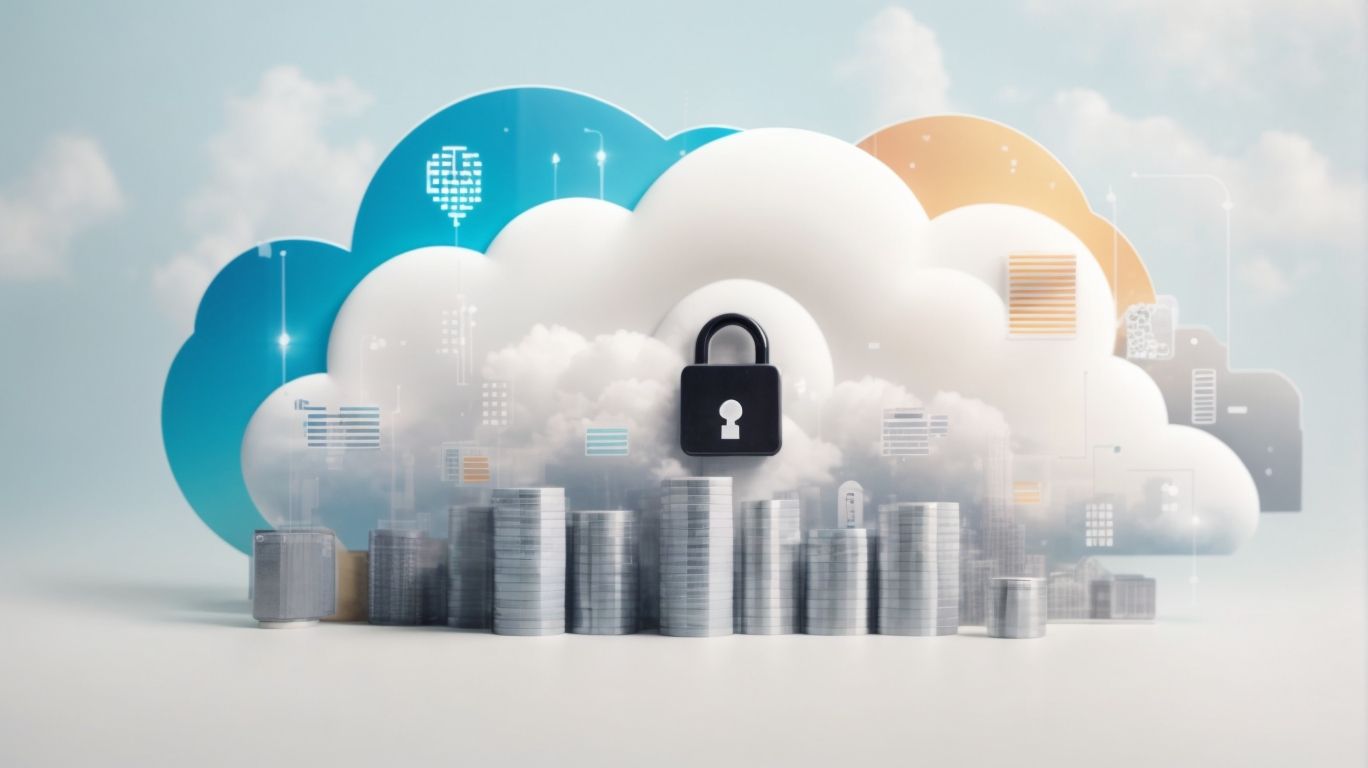In today’s digital age, online banking has become a convenient way to manage our finances. With this convenience comes the risk of cyber threats.
We will explore the importance of online banking security and how you can protect your financial information. From creating strong passwords to identifying common online banking scams, we will provide you with essential tips to safeguard your money.
Stay informed and keep your online transactions secure!
Table of Contents
Key Takeaways:
Protect your financial information by creating strong and unique passwords, enabling two-factor authentication, keeping devices and software updated, and using secure networks.Be cautious of common online banking scams such as phishing, malware attacks, and fake websites and apps. Always double check URLs and use trusted and official apps.If you suspect fraud or identity theft, contact your bank immediately, change your passwords, and monitor your accounts regularly to safeguard your financial information.
What Is Online Banking Security?
Online banking security refers to the measures and protocols implemented by financial institutions to safeguard customers’ sensitive information and financial transactions conducted through digital platforms.
Enhancing the protection of personal data and funds, online banking security plays a crucial role in maintaining trust and confidence in the digital financial landscape.
Encryption methods, such as SSL (Secure Sockets Layer) and TLS (Transport Layer Security), are commonly used to scramble data, making it inaccessible to unauthorized individuals. Employing two-factor authentication adds an extra layer of defense by requiring not only a password but also a second identifying factor, like a fingerprint or OTP (One-Time Password). This multi-step verification process greatly reduces the risk of fraudulent access to accounts. Secure networks, coupled with firewalls and intrusion detection systems, further fortify online banking security by keeping cyber threats at bay. These networks are designed to monitor and filter incoming traffic, identifying suspicious activities that may pose a threat to the system.
In short, the synergy of encryption techniques, multi-factor authentication, and fortified networks acts as a robust shield against cyber threats, ensuring the safety and confidentiality of online banking transactions.
Why Is Online Banking Security Important?
Online banking security is crucial due to the increasing threats posed by cybercriminals targeting financial institutions and attempting to exploit vulnerabilities in data encryption processes.
In today’s digital age, the protection of sensitive personal and financial information has become paramount.
Financial institutions play a vital role in safeguarding customer data by implementing robust security measures such as two-factor authentication, encryption protocols, and regular security audits. Despite these efforts, cybercriminals are constantly evolving their tactics, using sophisticated phishing scams, malware, and social engineering techniques to access confidential data. It is essential for customers to remain vigilant, regularly update their passwords, avoid sharing sensitive information online, and report any suspicious activities to their financial institutions.
What Are the Risks of Not Having Proper Online Banking Security?
The absence of robust online banking security measures exposes individuals to risks such as data breaches, financial scams, cybercrime activities like customer account takeover, and compromises information security.
Online banking has become an essential part of modern financial transactions, offering convenience and accessibility like never before. This convenience also comes with risks. Cybercriminals are constantly devising new ways to exploit vulnerabilities in online banking systems. A single data breach can lead to devastating consequences, including identity theft, loss of funds, and damage to credit scores.
Financial scams, particularly phishing attacks, are on the rise, tricking unsuspecting users into divulging their sensitive information. Customer account takeover is another prevalent threat, where hackers gain unauthorized access to accounts and carry out fraudulent activities.
How Can You Protect Your Financial Information?
Protecting your financial information involves implementing strong passwords, enabling two-factor authentication, regularly updating devices and software to prevent vulnerabilities, and adopting secure practices.
In today’s digital landscape, where cyber threats are on the rise, taking proactive steps to safeguard your financial information is paramount. One essential aspect of protection is creating complex passwords that are unique to each account, combining uppercase and lowercase letters, numbers, and special characters. It’s also crucial to avoid using easily guessable information like birthdays or pet names.
The added layer of security provided by enabling two-factor authentication significantly reduces the risk of unauthorized access. This feature requires not only something you know (like a password) but also something you have, such as a code sent to your phone. This extra step can thwart many hacking attempts, even if your password is compromised.
Keeping your devices and software up-to-date is vital in preventing cyber attacks. Manufacturers often release patches and updates to fix vulnerabilities that hackers can exploit. By regularly installing these updates, you can strengthen your defenses and stay ahead of potential security threats.
Create Strong and Unique Passwords
Creating strong and unique passwords is essential to enhance account security, protect sensitive data from cybercriminals, and prevent unauthorized access to accounts.
Regarding choosing a password, be sure to avoid common patterns such as ‘123456’ or ‘password’. Instead, opt for a combination of uppercase and lowercase letters, numbers, and special characters. Utilizing a passphrase or using a password manager can also help you generate and store complex passwords securely. It is crucial to enable two-factor authentication whenever possible to add an extra layer of security.
Encryption plays a vital role in safeguarding data. Techniques like end-to-end encryption and SSL/TLS encryption help protect information during transmission and storage, making it difficult for hackers to intercept and decipher sensitive data. By implementing encryption measures, you can ensure that your data remains secure and confidential.
Unfortunately, compromised accounts remain a prevalent issue in the digital world. Phishing attacks, malware infections, and brute force attacks are common cyber threats that can lead to unauthorized access to your accounts. Being wary of suspicious emails, keeping software up to date, and monitoring account activity regularly are essential practices to mitigate the risk of falling victim to these attacks.
Enable Two-Factor Authentication
Enabling two-factor authentication adds an extra layer of security to your online banking accounts, reducing the risk of unauthorized access by hackers and enhancing overall account protection.
This security feature requires users to provide two different forms of identification before gaining access to their accounts, such as a password and a unique code sent to their mobile device. By implementing two-factor authentication, individuals significantly decrease the likelihood of falling victim to phishing scams or data breaches that target login credentials alone.
This method can prevent identity theft and secure sensitive financial information from cybercriminals seeking to exploit vulnerabilities in traditional password-based systems.
Keep Your Devices and Software Updated
Regularly updating your devices and software is crucial to address security vulnerabilities, mitigate risks of malware attacks, and ensure optimal protection against potential maintenance outages.
When you update your devices and software, you are not just adding new features or improvements; you are also strengthening your defenses against cyber threats. Device and software updates often contain patches for known security vulnerabilities, helping to prevent hackers from exploiting weaknesses in your system.
Antivirus software plays a critical role in safeguarding your devices against malware. It acts as a shield by scanning for and removing malicious programs that can harm your data or disrupt your system’s operations.
Staying current with security patches is equally essential. Companies release these patches to address newly discovered vulnerabilities and strengthen the overall security of their products. By applying these patches promptly, you reduce the likelihood of falling victim to cyber-attacks that target known weaknesses.
Use Secure Networks
Utilizing secure networks, such as encrypted Wi-Fi connections, is essential to protect your online banking activities from potential cybersecurity threats and ensure compliance with privacy policies.
Public Wi-Fi networks, commonly found in cafes, airports, and hotels, pose a significant risk to your sensitive banking information. Hackers can intercept data transmitted over these networks, potentially leading to identity theft or financial fraud.
Cybersecurity measures, such as firewalls, encryption protocols, and multi-factor authentication, play a crucial role in safeguarding your online transactions. Financial institutions implement stringent privacy policies to protect customer data and uphold confidentiality.
What Are the Most Common Online Banking Scams?
Common online banking scams include phishing scams that aim to trick users into revealing sensitive information, malware attacks targeting financial data, and fake websites or apps designed to deceive customers.
Phishing scams typically involve sending fraudulent emails or messages that appear to be from legitimate financial institutions, asking users to update their account details or verify personal information. These scams often use urgency or threats to pressure individuals into providing their usernames, passwords, or credit card details.
Malware attacks, on the other hand, infect users’ devices with malicious software, allowing hackers to steal sensitive financial data such as login credentials or credit card information. This type of attack can occur through infected email attachments, deceptive links, or unsecured websites.
Another prevalent threat is fake websites or apps that mimic trusted banking platforms to trick users into entering their personal information. These fraudulent websites may look convincing, but they are designed to capture sensitive data and use it for illegal activities.
Phishing Scams
Phishing scams involve fraudulent attempts to obtain sensitive information such as login credentials, personal details, and financial data through deceptive emails or messages, posing significant risks to individuals’ accounts and data security.
In these elaborate schemes, scammers often disguise themselves as trustworthy entities like banks, government agencies, or well-known companies to deceive unsuspecting victims. They employ various tactics such as creating fake websites that mimic legitimate ones, sending urgent messages to prompt immediate action, or using social engineering techniques to manipulate individuals into disclosing confidential information.
To protect yourself from falling victim to these fraudulent activities, it’s crucial to verify the source of any communication requesting sensitive information. Be cautious of unsolicited emails asking for personal data, scrutinize website URLs for inconsistencies, and avoid clicking on suspicious links or attachments. By staying vigilant and informed about common phishing tactics, you can reduce the likelihood of falling prey to online scams.
Malware Attacks
Malware attacks target online banking users by infecting devices with malicious software designed to steal sensitive information, compromise data encryption methods, and exploit vulnerabilities in security protocols.
These attacks pose serious risks not only to individual account holders but also to credit unions and financial institutions as a whole. The potential consequences of a successful malware attack extend beyond financial loss; they can damage an institution’s reputation, erode customer trust, and lead to costly regulatory repercussions.
Given these implications, it is paramount for organizations to implement robust data encryption measures to safeguard against such malicious activities. Utilizing industry-standard encryption protocols, regularly updating security software, and educating employees and customers about cybersecurity best practices are crucial steps in fortifying defenses against malware threats.
Fake Websites and Apps
Fake websites and apps imitate legitimate banking platforms to deceive users into sharing confidential information, leading to financial fraud, data breaches, and potential compromise of sensitive details shared through banking alerts.
In today’s digital age, cybercriminals have become increasingly sophisticated in creating fake websites and applications that closely resemble trusted banking sources, tricking unsuspecting individuals into divulging personal data like login credentials, credit card details, and identity information.
These scams not only result in financial losses but also put customers at risk of identity theft and unauthorized access to their accounts. With the rising number of online transactions, it is crucial to stay alert and cautious when navigating the virtual landscape of online banking.
How Can You Identify and Avoid Online Banking Scams?
Identifying and avoiding online banking scams requires vigilance against suspicious emails, links, and websites that may contain phishing attempts, malware infections, or fraudulent schemes aiming to perpetrate identity theft.
Phishing scams often involve deceptive emails or messages that mimic legitimate financial institutions, tricking individuals into divulging confidential information such as usernames, passwords, or credit card details.
Malware can be stealthily inserted into devices through seemingly harmless links or downloads, compromising sensitive data and granting unauthorized access to personal accounts.
Enhancing your online security measures involves implementing strong, unique passwords, enabling two-factor authentication, regularly updating anti-virus software, and avoiding public Wi-Fi for sensitive transactions.
Be Wary of Suspicious Emails and Links
Exercise caution when encountering unsolicited emails or suspicious links in online communications, as these may be phishing attempts or avenues for cybercriminals to engage in financial scams targeting unsuspecting individuals.
Phishing tactics often involve sending emails that appear to be from legitimate financial institutions or reputable sources, tricking recipients into providing sensitive information such as login credentials or personal details.
Clicking on malicious links within these emails can lead to malware infections, unauthorized access to accounts, or identity theft.
It is essential to verify the authenticity of any communication before sharing personal information or clicking on links, as cyber threats continue to evolve and pose serious risks to online security.
Double Check Website URLs
Verifying website URLs for authenticity and secure connections is essential to prevent falling victim to fake websites or phishing attempts, ensuring data security and leveraging the expertise of cybersecurity providers in identifying potential risks.
When engaging in online banking or any digital financial transactions, it is crucial to double-check the URL of the website before entering any sensitive information. A legitimate banking website will often have ‘https://’ at the beginning of the address, indicating a secure connection through encryption. Always scrutinize the domain name carefully to detect any small discrepancies or misspellings that could signal a fraudulent site attempting to mimic the original. Cybersecurity providers play a pivotal role in developing advanced technologies and strategies to protect users from falling prey to malicious websites and online scams.
Use Trusted and Official Apps
Opt for trusted and officially verified banking apps to mitigate the risks of fraudulent applications, enhance cybersecurity protections, and consider utilizing VPN services for an additional layer of privacy and security.
Legitimate banking apps play a crucial role in safeguarding your financial transactions from potential cyber threats. By using these secure platforms, you benefit from robust encryption protocols and multi-factor authentication, ensuring that your sensitive data remains confidential and protected.
Cybersecurity measures embedded in reputable banking applications continuously monitor for any suspicious activities, promptly detecting and thwarting any unauthorized access attempts. This proactive approach adds an extra shield against hackers and cybercriminals attempting to breach your financial accounts.
What Should You Do if You Suspect Fraud or Identity Theft?
In case of suspected fraud or identity theft, promptly contact your bank to report the incident, update your passwords, and initiate monitoring of your accounts to detect any unauthorized activities, while considering informing relevant credit bureaus.
After contacting your bank, it is vital to reset your passwords immediately. Choose strong, unique combinations that include a mix of letters, numbers, and special characters to enhance security.
Simultaneously, regularly monitor your accounts for any unusual transactions. Set up alerts for any withdrawals or purchases over a certain threshold to receive instant notifications of account activities.
It is crucial to notify the credit bureaus about the suspected fraud or identity theft to place a fraud alert on your credit report, helping prevent unauthorized credit applications.
Contact Your Bank Immediately
Alerting your bank about suspected fraud is imperative to prevent further unauthorized access to your accounts, secure your financial information, and engage their expertise in investigating and resolving security breaches.
Financial institutions play a crucial role in safeguarding your funds and personal information from fraudulent activities. When you contact your bank promptly, they can freeze your accounts, block unauthorized transactions, and initiate investigations to track and stop any ongoing fraud attempts. Immediate action is key to minimizing potential losses and preventing future security threats on your accounts.
Change Your Passwords
Changing your passwords after suspected fraud incidents is essential to prevent customer account takeovers, enhance information security, and reinforce your defense against potential security breaches, alongside considering security software solutions.
Regularly updating your login credentials not only safeguards your sensitive data but also mitigates the risks of unauthorized access to your accounts, reducing the likelihood of identity theft and financial loss.
- Account takeovers are on the rise, with hackers constantly devising sophisticated methods to breach security measures.
- By incorporating robust antivirus software into your digital arsenal, you add an extra layer of protection against malware, phishing attacks, and other cyber threats.
Implementing strong, unique passwords across different platforms and enabling two-factor authentication can fortify your online security posture, creating barriers that deter potential cybercriminals from infiltrating your accounts.
Monitor Your Accounts Regularly
Regularly monitoring your accounts for unusual activities, scams, or signs of data breaches is crucial to ensure regulatory compliance, detect potential security threats, and protect your financial information from unauthorized access.
By staying vigilant and checking your transaction history frequently, you can catch any suspicious transactions early on, preventing financial losses and identity theft. Keeping a close eye on your account balances and setting up alerts for any out-of-the-ordinary activities can provide an added layer of security. In the unfortunate event of a security breach, prompt detection and reporting can mitigate the extent of damage and improve the chances of recovering any lost funds.
Adhering to industry regulations is not just about compliance; it is about safeguarding your own financial well-being. A comprehensive understanding of these regulations give the power tos account holders to make informed decisions and reinforces the trustworthiness of financial institutions. Strong regulatory compliance practices serve as a shield against cyber threats and fraudulent activities, ensuring the confidentiality and integrity of sensitive financial data. https://www.youtube.com/embed/F5l2BucBfKY
Frequently Asked Questions
What is online banking security and why is it important?
Online banking security refers to the measures and protocols put in place to protect your financial information when using online banking services. It is important because it helps prevent unauthorized access to your accounts and ensures the safety of your funds.
What are some common methods used to safeguard financial information?
Some common methods used to safeguard financial information include two-factor authentication, encryption, and firewalls. These measures help prevent hackers and cybercriminals from accessing your sensitive financial information.
How can I ensure the security of my online banking transactions?
To ensure the security of your online banking transactions, make sure to use a secure and trusted internet connection, regularly update your devices and software, and never share your login credentials with anyone.
What should I do if I suspect fraudulent activity on my online banking account?
If you suspect fraudulent activity on your online banking account, contact your bank immediately and report the suspicious activity. They will be able to freeze your account and investigate the issue to protect your financial information.
Is it safe to use public Wi-Fi for online banking?
No, it is not safe to use public Wi-Fi for online banking as it is not a secure network. Hackers can easily intercept your connection and gain access to your financial information. It is best to use a secure and trusted internet connection for online banking transactions.
What should I do to protect my online banking security?
To protect your online banking security, make sure to regularly monitor your accounts for any suspicious activity, choose strong and unique passwords, and never click on links or open attachments from unknown sources. It is also important to educate yourself on the latest security threats and stay updated on security measures.






